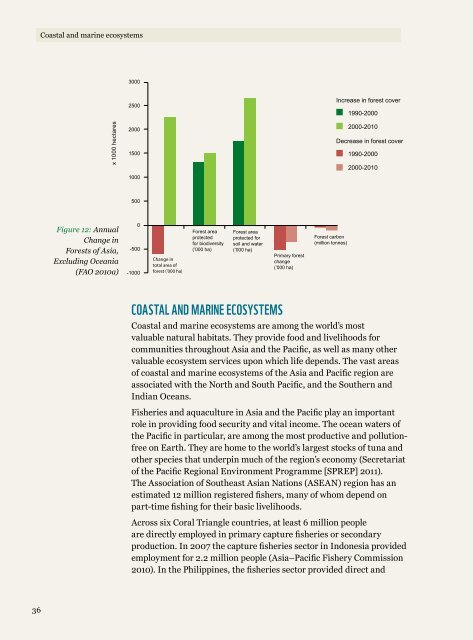Download the pdf - Global Footprint Network
Download the pdf - Global Footprint Network
Download the pdf - Global Footprint Network
Create successful ePaper yourself
Turn your PDF publications into a flip-book with our unique Google optimized e-Paper software.
Change in<br />
total area of<br />
forest ('000 ha)<br />
36<br />
Coastal and marine ecosystems<br />
x 1000 hectares<br />
Figure 12: Annual<br />
Change in<br />
Forests of Asia,<br />
Excluding Oceania<br />
(FAO 2010a)<br />
3000<br />
2500<br />
2000<br />
1500<br />
1000<br />
500<br />
0<br />
-500<br />
-1000<br />
Change in<br />
total area of<br />
forest ('000 ha)<br />
Forest area<br />
protected<br />
for biodiversity<br />
(’000 ha)<br />
Forest area<br />
protected for<br />
soil and water<br />
(’000 ha)<br />
CoAstAL AnD MARIne eCosYsteMs<br />
Primary forest<br />
change<br />
(’000 ha)<br />
Forest carbon<br />
(million tonnes)<br />
Increase in forest cover<br />
Increase in forest cover<br />
1990-2000<br />
2000-2010<br />
1990-2000<br />
Decrease in forest cover<br />
2000-2010<br />
1990-2000<br />
2000-2010<br />
Decrease in forest cover<br />
1990-2000<br />
2000-2010<br />
Coastal and marine ecosystems are among <strong>the</strong> world’s most<br />
Forest area Forest area<br />
protected valuable protected natural for habitats. They provide Forest food and carbon livelihoods for<br />
for biodiversity communities soil and water throughout Asia and <strong>the</strong> Pacific, (million tonnes) as well as many o<strong>the</strong>r<br />
(’000 ha) valuable (’000 ecosystem ha) services upon which life depends. The vast areas<br />
of coastal and marine Primary ecosystems forestof<br />
<strong>the</strong> Asia and Pacific region are<br />
change<br />
associated with <strong>the</strong> North and South Pacific, and <strong>the</strong> Sou<strong>the</strong>rn and<br />
(’000 ha)<br />
Indian Oceans.<br />
Fisheries and aquaculture in Asia and <strong>the</strong> Pacific play an important<br />
role in providing food security and vital income. The ocean waters of<br />
<strong>the</strong> Pacific in particular, are among <strong>the</strong> most productive and pollutionfree<br />
on Earth. They are home to <strong>the</strong> world’s largest stocks of tuna and<br />
o<strong>the</strong>r species that underpin much of <strong>the</strong> region’s economy (Secretariat<br />
of <strong>the</strong> Pacific Regional Environment Programme [SPREP] 2011).<br />
The Association of Sou<strong>the</strong>ast Asian Nations (ASEAN) region has an<br />
estimated 12 million registered fishers, many of whom depend on<br />
part-time fishing for <strong>the</strong>ir basic livelihoods.<br />
Across six Coral Triangle countries, at least 6 million people<br />
are directly employed in primary capture fisheries or secondary<br />
production. In 2007 <strong>the</strong> capture fisheries sector in Indonesia provided<br />
employment for 2.2 million people (Asia–Pacific Fishery Commission<br />
2010). In <strong>the</strong> Philippines, <strong>the</strong> fisheries sector provided direct and

















